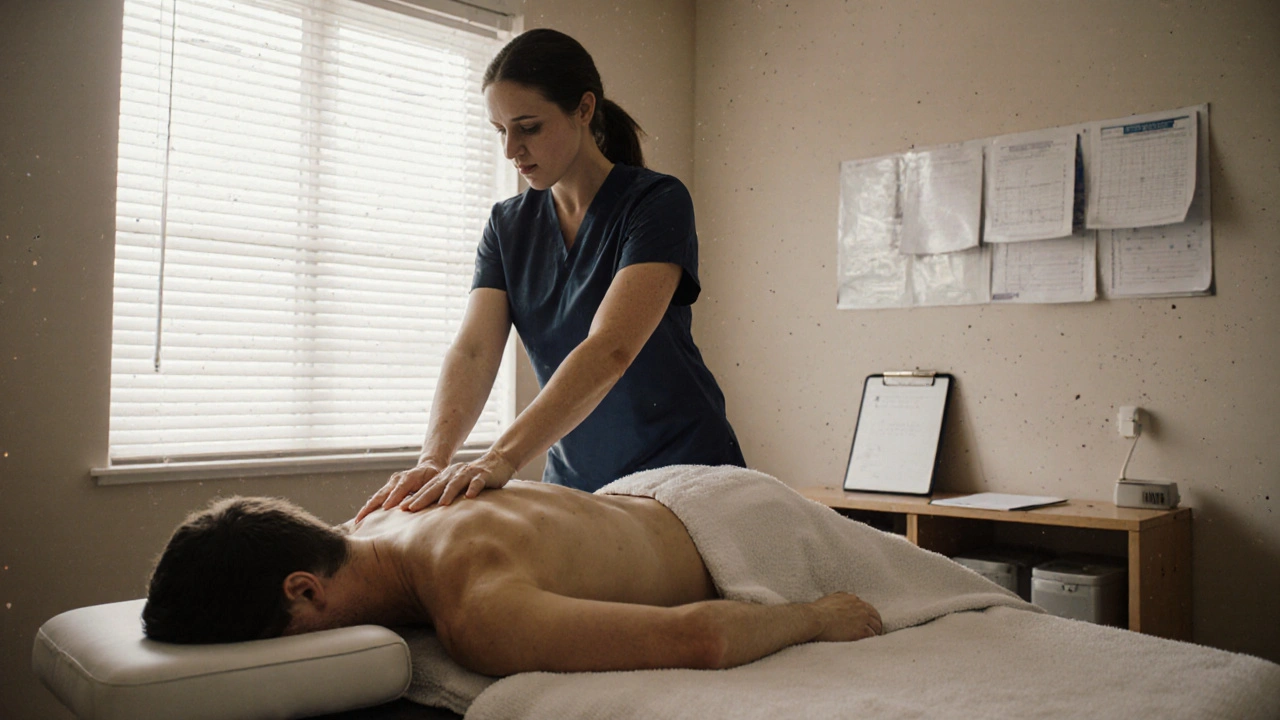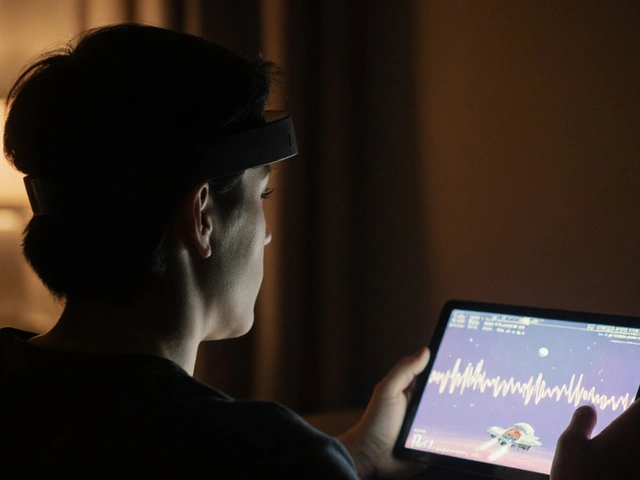Medical Massage Symptom Checker
Find Out If Medical Massage Is Right For You
Answer a few questions about your symptoms to determine if medical massage might help address your condition.
Results
Most people think of massage as a luxury - something you do on vacation or after a long week. But medical massage isn’t about relaxation alone. It’s a targeted, evidence-based treatment used by doctors, physiotherapists, and rehabilitation centers to treat real health issues. If you’re dealing with chronic back pain, tension headaches, sciatica, or recovery from surgery, medical massage could be the missing piece in your wellness plan.
What Exactly Is Medical Massage?
Medical massage is different from spa massage. It’s not about aromatherapy, hot stones, or ambient music (though those can be added). It’s a clinical approach where the therapist uses specific techniques to address diagnosed conditions. The goal isn’t just to feel good - it’s to improve mobility, reduce inflammation, break down scar tissue, and restore function.
Think of it like physical therapy, but using hands instead of machines. A medical massage therapist studies anatomy, physiology, and pathology. They don’t guess what’s wrong - they work from a referral, a doctor’s note, or a clear diagnosis. Common conditions treated include:
- Chronic lower back pain from herniated discs
- Tennis elbow and repetitive strain injuries
- Post-surgical scarring and stiffness
- Neuropathic pain from diabetes or nerve compression
- Migraines triggered by neck and shoulder tension
Unlike general massage, medical massage follows a treatment plan. You won’t just get one session and call it a day. Most patients need 4-8 sessions over several weeks, with progress tracked through pain scales, range-of-motion tests, and functional movement checks.
How It Works: Science Behind the Pressure
Medical massage doesn’t work by magic. It works because of biology. When you have chronic pain, your muscles tighten up as a protective response. That tightness cuts off blood flow, traps metabolic waste, and irritates nerves. Over time, this creates a cycle: pain → tension → more pain.
Medical massage breaks that cycle in three ways:
- Increases circulation: Pressure applied to tight areas brings fresh oxygen and nutrients to damaged tissue. A 2023 study in the Journal of Bodywork and Movement Therapies showed that targeted massage increased blood flow by up to 47% in treated muscle groups within 20 minutes.
- Reduces inflammation: Massage stimulates the parasympathetic nervous system, which lowers cortisol and inflammatory markers like IL-6. This is especially helpful for arthritis and tendonitis.
- Resets nerve signaling: Chronic pain can make nerves hypersensitive. Massage helps desensitize them by flooding the brain with non-painful sensory input - a process called gate control theory.
Techniques vary depending on the issue. Deep tissue work for muscle knots, myofascial release for connective tissue restrictions, trigger point therapy for referred pain, and lymphatic drainage for swelling. A good therapist will adjust pressure, angle, and duration based on your feedback and progress.
Who Can Benefit - And Who Should Avoid It
Medical massage isn’t for everyone, but it helps far more people than you might think.
Good candidates include:
- People with desk jobs who get daily neck and shoulder pain
- Older adults with osteoarthritis in hips or knees
- Athletes recovering from sprains or overuse injuries
- Patients undergoing cancer treatment (for lymphedema and fatigue)
- Those with fibromyalgia or chronic fatigue syndrome
Conditions where medical massage should be avoided or modified:
- Open wounds, burns, or recent fractures
- Deep vein thrombosis (blood clots)
- Severe osteoporosis with recent vertebral fractures
- Active infections or fever
- Uncontrolled high blood pressure
If you’re unsure, talk to your GP or physiotherapist. Many clinics now have integrated care teams where massage therapists work alongside doctors - no guesswork needed.

What to Expect in Your First Session
Your first visit isn’t like walking into a spa. There’s no robe or herbal tea (unless you ask). Instead, you’ll sit down with the therapist and go through a short intake.
They’ll ask:
- What’s your main complaint?
- When did it start?
- What makes it better or worse?
- Have you had imaging done? (X-rays, MRIs)
- Are you taking any medications?
They might also do a quick movement test - asking you to bend, reach, or walk - to see how your body moves. Then they’ll explain which techniques they’ll use and why.
The massage itself is usually done on a table, fully clothed or draped, depending on your comfort. You’ll be asked to give constant feedback: “Too much,” “That’s the spot,” “Ease up.” There’s no holding your breath or enduring pain. If it hurts, say so. Medical massage should feel intense, not unbearable.
Afterward, you might feel a little sore - like after a good workout - but not worse than before. Many people report feeling lighter, breathing easier, or sleeping better that night.
How It Fits Into Your Broader Wellness Plan
Medical massage isn’t a cure-all. But it’s a powerful tool when combined with other healthy habits.
For example:
- If you have lower back pain, massage can reduce muscle tension - but you’ll also need core strengthening exercises.
- If you get frequent headaches, massage can release neck tightness - but you’ll need to check your posture at your desk and screen height.
- If you’re recovering from knee surgery, massage can reduce swelling - but you’ll still need physical therapy and gradual movement.
The best outcomes come when massage is part of a team. A 2024 review in the British Journal of Sports Medicine found that patients who combined medical massage with movement therapy and education saw 68% greater improvement in pain and function than those who did massage alone.
Think of it this way: massage clears the road. Exercise rebuilds the vehicle. Nutrition fuels it. You need all three to keep moving forward.
Finding the Right Therapist
Not every massage therapist is trained in medical work. Look for someone with:
- Certification in medical or clinical massage therapy
- Experience working with physiotherapists or rehab clinics
- Ability to explain their techniques using anatomical terms
- Willingness to communicate with your doctor (with your permission)
In Australia, check if they’re registered with the Australian Health Practitioner Regulation Agency (AHPRA) or a recognized body like the Australian Association of Massage Therapy. Ask if they’ve treated patients with your specific condition before.
Don’t be afraid to ask for references or case studies. A good therapist will have a record of progress notes and outcomes - not just a list of happy reviews.

Insurance and Costs
Medical massage is often covered under private health insurance in Australia under “extras” policies - especially if it’s prescribed by a GP or physiotherapist. Check your policy for “remedial massage” or “clinical massage” coverage. Some policies cover up to $500 per year.
Out-of-pocket costs vary. A 60-minute session typically runs between $80-$130, depending on location and therapist experience. Some clinics offer package deals for 5-10 sessions, which can bring the cost down by 15-20%.
Medicare doesn’t cover massage directly - but if you’re on a Chronic Disease Management (CDM) plan, your GP can refer you to allied health professionals, and some massage therapists accept these referrals.
Real Results: Stories From Real People
Emma, 52, had been living with sciatica for 18 months. Painkillers helped a little, but she couldn’t walk more than 10 minutes without stopping. After four weeks of weekly medical massage focused on her piriformis muscle and lower lumbar region, she was hiking again - no meds needed.
James, 38, developed chronic tension headaches after switching to remote work. His shoulders were so tight he couldn’t turn his head fully. After six sessions of trigger point therapy and posture correction advice, his headaches dropped from 5 days a week to 1.
These aren’t outliers. They’re common outcomes when medical massage is done right.
Why This Isn’t Just Another Wellness Trend
Medical massage has been used in hospitals and rehab centers since the 1970s. It’s not new. What’s new is how accessible it’s becoming.
Unlike expensive surgeries or long-term medication use, medical massage is low-risk, non-invasive, and has almost no side effects. It doesn’t mask pain - it helps your body heal itself.
And in a world where we’re over-medicated and under-moved, sometimes the best medicine is a skilled pair of hands - working with your body, not against it.
Is medical massage the same as physiotherapy?
No, but they work well together. Physiotherapy uses exercises, machines, and movement retraining to restore function. Medical massage focuses on soft tissue - muscles, tendons, fascia - to reduce pain and improve mobility. Many physiotherapists refer patients to massage therapists and vice versa.
Can medical massage help with stress and anxiety?
Yes, but indirectly. While it’s not a mental health treatment on its own, reducing physical pain and muscle tension lowers cortisol levels and activates the parasympathetic nervous system. This naturally calms the mind. Many people report better sleep and less mental fog after consistent sessions.
How many sessions will I need?
It depends on your condition. Acute issues like a recent strain might need 3-5 sessions. Chronic problems like long-term back pain often require 6-12 sessions over 6-10 weeks. Most therapists will reassess after 4 sessions to see if you’re progressing.
Does it hurt?
It should feel intense, not painful. You might feel a deep ache or burning sensation when pressure hits a tight spot, but it should never be sharp or unbearable. If it hurts too much, tell your therapist. Good medical massage is always guided by your feedback.
Can I do medical massage at home?
You can use foam rollers, massage balls, or handheld devices for mild relief, but they can’t replace professional medical massage. Therapists have years of training to identify tissue restrictions, apply precise pressure, and adjust techniques based on your body’s response. DIY tools are great for maintenance - not diagnosis or treatment.
If you’ve been living with pain and thinking, “This is just part of getting older,” think again. Medical massage isn’t about fixing what’s broken - it’s about helping your body remember how to heal itself. And sometimes, that’s all you need to get back to living.





